New York City Art Museums |
New York City has to be one of the greatest places in America, if not the world.
Luckily for us, many authors have chronicled The Big Apple's antics in a way just right
for kids.
Here are some of
the books available. This is not yet a complete list, but I'm adding
books to the list daily. If you wish to purchase any of these books, click on either the title or the book cover to be directed to Amazon.com. As a warning, I have put up pictures of the book covers to give you somewhat an idea of the style of each book (I know, I know. "Don't judge a book by its cover") so the pages may load slowly, depending on the speed of your internet connection.
The categories below are sorted by approximate age group and topical categories. Feel free to browse around. The same links are located on the left side of your screen. To return back to this page, simply click on the "Welcome" link on the left.
If this website came up without frames, click here to see the complete "New York City Books for Kids" website with frames.
For books about the American Museum of Natural History, go to the Natural History Museum Books Page.
Other Pages of Interest:
Fiction & Historical Fiction:
General Books About New York City (Nonfiction) |
Fiction NYC Picture Books and "Easy Reader" Stories (Ages 4-8) |
Fiction NYC Books (Ages 9-12) |
New York Fiction for Young Adults |
New York Historical Fiction (Colonial Period and Revolutionary War) |
New York Historical Fiction (Ellis Island & Immigration) |
New York Historical Fiction (Life in the 1800s) |
New York Historical Fiction (Life in the 1900s)
NYC History:
New York Biographies |
Native Americans from New York (History and Historical Fiction) |
New York History (Colonial Period and Revolutionary War) |
New York History (Immigration and Ellis Island) |
New York History (The 1800s) |
New York History (The 1900s) |
The World Trade Center and September 11, 2001 |
NYC Locations:
The Statue of Liberty |
The Empire State Building |
Central Park |
NYC Art Museums (Metropolitan Museum of Art, The Museum of Modern Art, etc.) |
NYC's American Museum of Natural History |
Harlem Books (Including books about the Harlem Renaissance) |
Chinatown Books |
Little Italy Books |
The New York City Subway System |
Brooklyn Books |
The Bronx Books |
Queens Books |
Staten Island Books |
Long Island Books |
Upstate New York Books |
New York State Books
Life and Travel in NYC:
Thanksgiving in New York City |
Christmas in New York City |
New York Sports Teams and Players
The NYC Fire Department (FDNY) and NY Police Department (NYPD) |
General Books About Cities |
New York City and New York State Test Preparation and Study Guides |
New York Regents Review Books |
Parenting in New York City |
New York Travel Guides for Families with Children
NYC Toys, Puzzles, and Games (For Kids & Adults) |
Amazon.com Coupon Codes
Books for Beginning Readers
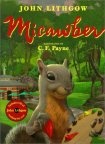
Micawber
By John Lithgow
(Includes a CD of John Lithgow reading the text)
The team behind The Remarkable Farkle McBride returns with another high-spirited tale celebrating the arts. While young Farkle found joy in orchestral music, Micawber the squirrel is a lover of the fine art of painting. The refined New York City rodent makes a weekly scamper from his Central Park nest to the nearby "palace on Fifth Avenue" (the Metropolitan Museum of Art), where he can "feast... his eyes and his heart" on countless masterworks. On one such museum visit Micawber stows away among an art student's supplies and winds up in the woman's apartment, where he clandestinely uses her equipment to paint his own canvases, substituting his bushy tail for a brush. As months pass, the benign bandit assembles his own colorful gallery in his home atop the park's carousel. In a tighter, more linear text than Farkle, Lithgow conveys the sense of discovery and emotional enjoyment one can experience while observing or creating art. The vast majority of lines here have a musical rhythm, though young readers may need to puzzle out the meaning of words like "peregrination." Payne's mixed-media compositions capture an area of Manhattan at its clean, sunny best. His varying perspectives and occasionally paint-splattered backgrounds embrace all the exhilaration of Lithgow's words.
Description from Publishers Weekly
The team who created The Remarkable Farkle McBride now puts forth a delightful story of an art aficionado who happens to be a squirrel. The rodent visits the Metropolitan Museum of Art regularly, peering in through the skylight at his favorite works. One day, he slips into the paintbox of a student who'd been copying the great masters and becomes a stowaway on her journey home. All summer he explores the wonder of color and process while she sleeps, his tail serving as a brush, until he has enough art to start his own gallery atop Central Park's carousel. The last scene is a foldout of park friends with paper cups and cheese, attending his opening. The rhymed text sparkles with pleasing sounds like "beguiler" and "alizarin crimson," or intriguing terms such as "peregrination," all the while remaining completely accessible. White pages of narrative are splattered with paint. Lithgow's reading on the CD is brimming with texture and playful pomposity. The mixed-media illustrations depict an utterly fetching protagonist displaying a range of moods and poses. Endpapers reveal "self-portraits," with nods to Rembrandt and Rockwell. Kids will never again look at squirrels in quite the same way; indeed, they will wish to meet Micawber.
Description from School Library Journal
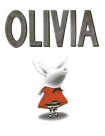
Olivia
By Ian Falconer
Awards:
- Caldecott Honor Book, 2001
- 2000 Parents' Choice Gold Award
Talk about charisma! Olivia, an irresistible young pig of boundless energy, has it in spades. In this her premiere appearance, we discover that red is her favorite color, that her younger brother Ian is a pest, and that she can be found at the Metropolitan Museum of Art most rainy days. It may not be much. But she leaves us clamoring for more. This is also a first picture book appearance by her creator. Falconer is a welcome breath of fresh air.
Description from Parents' Choice
From the articles of clothing strewn across the front endpapers of this droll account of Olivia's escapades, readers may surmise that this porcine heroine is no ordinary youngster. Olivia is constantly on the move, dreaming big dreams and meeting every challenge head-on. She doesn't just get dressed, she tries on every outfit in the closet. She doesn't just dance, she envisions herself as a prima ballerina bowing before an adoring audience. When her mother teaches her to build sand castles, Olivia creates a towering structure that closely resembles the Chrysler Building in New York City. When she views a Jackson Pollack painting in the museum, she immediately concludes that she can do better and proceeds to try her hand at painting a wall at home. Her efforts earn her time out and a bath. The text is brief, funny, and sometimes ironic in relation to the highly amusing illustrations. The only touches of color in the pictures, executed in charcoal and gouache, are the bright reds of the clothing or objects used by Olivia. There are often many renderings of the young pig on each large white background, effectively demonstrating her boundless energy. Even at day's end, she is still going strong, negotiating the number of books to be read at bedtime. For a lively storyhour featuring feisty females, pair this with Kevin Henkes's stories about Lilly.
Description from School Library Journal
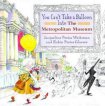
You Can't Take a Balloon into the Metropolitan Museum
By Jacqueline Preiss Weitzman and Robin Preiss Glasser
In this wordless book, a girl leaves her balloon with a guard before entering the museum. When the balloon sails away, the guard takes off in pursuit. As a series of chaotic scenes around Manhattan follow, the action is reflected in the works of art the girl is viewing inside the museum. Funny and elegant at the same timethanks to a remarkably evocative line, a sure sense of timing, and variations in perspective and layout.
Description from Horn Book
A little girl and her grandmother decide to visit the Metropolitan Museum of Art but are stopped at the main door by a guard who insists that the girl's yellow balloon be tied up outside until they are ready to leave. He promises to look after it for her. Naturally, while the girl and her grandmother explore the Art Museum, the yellow balloon blows away and the museum guard must chase after it. The balloon floats all over New York City into places that are very similar to the art that the girl and her grandmother are seeing in the museum. In this wordless picture book, each page holds several scenes to narrate the story. The art that the girl and her grandmother see in the museum are faithful reproductions. The artists' names and titles of their works appear in the back of the book.
Description from Children's Literature
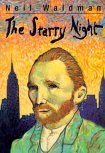
The Starry Night
By Neil Waldman
Waldman has created a nifty little fantasy based on the life of painter Vincent Van Gogh. Although the language is occasionally a little elliptical or awkward, the pictures will propel children happily forward. Bernard, who is hanging out with his friends in Central Park, is fascinated by a man painting on an easel. The man's name is Vincent, and he tells Bernard he's in search of places "that ask to be painted." So Bernard takes him all over the city. At the end, Vincent takes Bernard to the Museum of Modern Art, shows him Starry Night, and disappears, leaving Bernard captivated enough to sketch his own version of the painting. The drama of brilliantly colored oils and acrylics depicting New York scenes in Van Gogh's style juxtaposed with lively, sepia-toned pen-and-ink sketches of the city works well: as Bernard says, the Brooklyn Bridge, the Chrysler Building, and the Statue of Liberty "never looked so great." The endpapers include versions of Starry Night done by children Waldman has taught in art class.
Description from Booklist
Young Bernard comes across an old and frail looking artist painting in New York's Central Park, and is entranced. He sits in the grass and watches the man as the canvas is transformed into the dazzling reflecting pool and surrounding area. "The Big Apple never looked better!" As the painter packs his things, Bernard introduces himself. "Where are you going?" Bernard asked. "To find another place that asks to be painted." And so Bernard joins him and takes Vincent all over New York City, to Harlem, the Statue of Liberty, the Brooklyn Bridge, Greenwich Village, Chinatown, Times Square, and Fifth Avenue... "Everywhere they went, Bernard watched as Vincent painted New York in bright and beautiful colors." Finally it is time for Vincent to leave New York and move on. But before he goes, he takes Bernard to see something very special on the second floor of the Museum Of Modern Art.....
Neil Waldman has written a marvelous and inspiring fantasy that takes youngsters on a "Van Gogh" adventure through New York City. Mr Waldman's simple and gentle text takes a back seat to both his charming pen and ink story illustrations, and ingenious Van Gogh-styled, bold and bright New York scenes. Together word and art transports the reader on an evocative and entertaining journey with one of the great masters. Perfect for budding artists 4-8, The Starry Night is an engaging feast for the eyes; a portrait of the artist, his work and his unique style.
Description from Amazon.com Customer Review
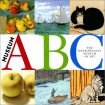
Museum ABC
By The Metropolitan Museum of Art
Museum ABC is a unique and colorful picture book that uses the alphabet to introduce children to more than a hundred works of art. A full spread is devoted to each letter of the alphabet and four pictures of the object represented.
This simple presentation scheme allows readers to see how objects can be both the same and different in the eyes of various artists, cultures, and time periods. Children will be fascinated to discover that boats, roses, trees, or even windows can be so different from one another and from those they see every day. Adults will love the visual and cultural richness of this alphabetical tour through the Metropolitan Museum's collection. A fact section at the end of the book provides more details about each piece of art and its creator.
Description from Publisher

ABC:
The Museum of Modern Art New York
By Florence Cassen Mayers
These ABC books feature objects from the title museums' collections to illustrate letters of the alphabet. Museum of Modern Art features Matisse's Dance for the letter "D," Picasso's bronze She-Goat for "G," Hopper's House by the Railroad for "H." Museum of Fine Arts shows an antique Pennsylvanian armchair for "A"; an Audubon picture from The Birds of America (a yellow-breasted chat nesting represents the letter "N"); and for "Y," the word youngsters, applied to Jefferson Gauntt's "Two Children". The skinny and tall 4 13 format may be unwieldy for small hands, but the selections are varied, and the interesting shapes and textures, brightly reproduced in color photos, will appeal to young children.
Description from Publishers Weekly
Books for Older Readers
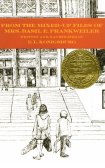
From the Mixed-Up Files of Mrs. Basil E. Frankweiler
By E. L. Konigsburg
Awards:
- Newbery Medal 1968
When Claudia decided to run away, she planned very carefully. She would be gone just long enough to teach her parents a lesson in Claudia appreciation. And she would go in comfort-she would live at the Metropolitan Museum of Art. She saved her money, and she invited her brother Jamie to go, mostly because be was a miser and would have money.
Claudia was a good organizer and Jamie had some ideas, too; so the two took up residence at the museum right on schedule. But once the fun of settling in was over, Claudia had two unexpected problems: She felt just the same, and she wanted to feel different; and she found a statue at the Museum so beautiful she could not go home until she bad discovered its maker, a question that baffled the experts, too.
The former owner of the statue was Mrs. Basil E. Frankweiler. Without her-well, without her, Claudia might never have found a way to go home.
Desciption from Publisher
Claudia is bored. She's ready for a big change, but wants to make sure she does it with style. When she decides to run away, Claudia plans to be a runaway with specific goals: to be comfortable, to be changed, and to be appreciated at home. She carefully appoints a partner (her younger brother), and selects a destination (The Metropolitan Museum of Art), but there are some adventures you simply can't plan in advance. Claudia and her brother Jamie are soon embroiled in an artistic mystery even the experts can't solve, but discovering a solution to this puzzle might just help Claudia find the answer to her personal quest.
Konigsburg's unique story, compelling style, and distinctive line drawings make this Newbery Medal-winner a book readers won't want to put down. Especially for children on the cusp of adolescence, Claudia's desire to be someone and her corresponding search for identity will ring true for those searching for their true selves.
Description from Amazon.com
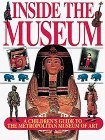
Inside the Museum:
A Children's Guide to the Metropolitan Museum of Art
By Joy Richardson
Objects displayed in New York City's Metropolitan Museum of Art are the focus here, but Richardson doesn't forget the activity that goes on behind the museum's closed doors. In fact, her photo tour of some of the museum's magnificent collections begins with a peek "backstage," where the organization, record keeping, and preservation of the artwork goes on. The many photographs are excellent and well chosen to give a fine sense of the building's contents--from mummy cases, costumes, and musical instruments to European paintings and twentieth-century sculpture. Unfortunately, the layout is crowded, the drawings provided are occasionally amateurish, and chapter changes are not clearly distinguished. However, Richardson's text is filled with fascinating facts, and she's included a few projects to help kids make the jump from armchair touring and appreciating to the actual art-making process.
Description from Booklist
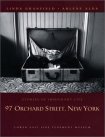
97 Orchard Street, New York:
Stories of Immigrant Life
by Linda Granfield
(Lower East Side Tenement Museum)
Guided by the stories of four families known to live in the titular tenement, author Linda Granfield provides an illuminating look at life at the turn of the century and beyond in 97 Orchard Street, New York: Stories of Immigrant Life. Arlene Alda's sensitive b&w photographs of the building, which has been preserved as the Lower East Side Tenement Museum, share space with historical images and artifacts from the museum's collection, as well as photographs of the neighborhood today.
Description from Publishers Weekly
The Lower East Side Tenement Museum opened in New York City in 1994. "Urban archeology," "diligent research," and "interviews with former residents" facilitated the re-creation of this building that housed immigrants from the mid-1800s to its closing in 1935. Essentially a photo-essay of material from the museum, the text is divided into 13 brief sections beginning with "Mystery: The Gumpertz Family." Readers learn that "Julius Gumpertz walked out of the building-on a crisp October morning in 1874" never to be heard from again. Working as a seamstress, his wife managed to support her four young children, one of whom "died of diarrhea, an all-too-common fate for nineteenth-century infants." Each black-and-white photograph is accompanied by a detailed caption. Other sections introduce three more families and also tell their stories through artifacts and oral histories. Additional segments such as "Early Immigration" and "Ellis Island: Portal of Hope" deal with more general aspects of immigration at that time. Chock-full of the simple details of everyday life as well as larger tales of human joy and suffering, this volume presents an intriguing window into urban tenements just before and after the turn of the century. Be aware that there is no table of contents, no index, and the information presented does not follow a simple time line. However, the book is a useful addition to general collections, especially as a starting point for further investigation.
Description from School Library Journal
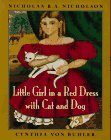
Little Girl in a Red Dress With Cat and Dog
By Nicholas B. A. Nicholson
In his first book, in homage to American folk art, Nicholson imagines the story behind the painting Portrait of a Little Girl in a Red Dress with Cat and Dog in the Museum of American Folk Art in New York City. The unnamed little girl narrates, describing how her portrait's creator, a self-taught artist named Ammi Phillips, traveled from state to state in the 1830s, painting farm families and depictions of country life. At her home, everyone else is too busy to pose, so she sits for the painting--and it's more difficult than she expected. While she is being painted, she gets to eat cherry tarts with the ladies in the parlor, and convinces Phillips to include Cat and Dog in the portrait at no extra cost. The first line, ``That's me over the fireplace,'' establishes a personal connection between readers and the girl, just as she establishes a connection with Phillips. In her picture-book debut, Von Buhler skillfully emulates the primitive folk-art style with characteristically solid, straight-mouthed figures and clean, flat lines.
Description from Kirkus Reviews
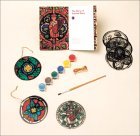
The Metropolitan Museum of Art Ornaments:
The Story of Stained Glass
Stained glass windows have long been admired for their beauty and utility. With this marvelous kit, you can now create your own ornamental pieces perfect for hanging on a Christmas tree or in a sun-lit window all year long. The kit contains six silk-screened plastic disk ornaments with designs adapted from windows in the Museum's collection, as well as six nontoxic, transparent paints, a brush, and silk cord for hanging--all the materials you'll need for bringing the beauty of stained glass art into your own home.
Included is a 32-page full-color book that discusses the history, assembly, and use of stained glass, as well as detailed instructions for making the ornaments.
Description from Publisher
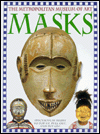
Metropolitan Museum of Art:
Book of Masks
Here are some of the most spectacular masks from the collection of the Metropolitan Museum of Art: a fierce samurai mask, a toothy Nigerian mask, an eerie skull mask from Papua New Guinea, a puffy-cheeked pre-Columbian mask, and a German helmet from the early 16th century. Each mask pops out of the book and can be worn and re-inserted onto the page for storage. Accompanying each mask, which are reproduced here with exceptional fidelity, is rich informative text which places these works of art into their larger historical and cultural contexts.
Description from Publisher
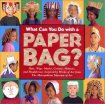
What Can You Do with a Paper Bag?
By Judith Cressy
The humblest of materials transform the pedestrian into the sublime in What Can You Do with a Paper Bag? by Judith Cressy, photos by Maria Quiroga and Christine A. Butler, illus. by Edward Heins. "Perseus' Winged Helmut," "George Washington's Hair" and a "Curly Baroque Wig" number among these 21 chic chapeaux, all inspired by paintings and sculptures at the Metropolitan Museum of Art.
Description from Publishers Weekly
With a little imagination, the answer is "plenty!" Armed with scissors, tape, and glue, it's easy to turn an ordinary paper bag into an extraordinary hat, wig, mask or crown. Simple step-by-step instructions show readers how to make a golden crown, a curly Baroque wig, Perseus's winged helmet, a pharaoh's headdress, George Washington's wig, a Japanese geisha hairdo, an African mask and sixteen other imaginative designs. An engaging activity book for both home and classroom, What Can You Do with a Paper Bag?, inspired by works of art from The Metropolitan Museum of Art, will provide hours of educational and entertaining dress-up fun.
Description from Publisher
Back to "New York City Books for Kids"
Still can't find what you're looking for? Search Amazon.com's database directly.
©2002-2003
(NOTE: The advertisements below have not been placed on the site by its owners. We are not responsible for their content.)
For books about the American Museum of Natural History, go to the Natural History Museum Books Page.
Other Pages of Interest:
Fiction & Historical Fiction:
General Books About New York City (Nonfiction) |
Fiction NYC Picture Books and "Easy Reader" Stories (Ages 4-8) |
Fiction NYC Books (Ages 9-12) |
New York Fiction for Young Adults |
New York Historical Fiction (Colonial Period and Revolutionary War) |
New York Historical Fiction (Ellis Island & Immigration) |
New York Historical Fiction (Life in the 1800s) |
New York Historical Fiction (Life in the 1900s)
NYC History:
New York Biographies |
Native Americans from New York (History and Historical Fiction) |
New York History (Colonial Period and Revolutionary War) |
New York History (Immigration and Ellis Island) |
New York History (The 1800s) |
New York History (The 1900s) |
The World Trade Center and September 11, 2001 |
NYC Locations:
The Statue of Liberty |
The Empire State Building |
Central Park |
NYC Art Museums (Metropolitan Museum of Art, The Museum of Modern Art, etc.) |
NYC's American Museum of Natural History |
Harlem Books (Including books about the Harlem Renaissance) |
Chinatown Books |
Little Italy Books |
The New York City Subway System |
Brooklyn Books |
The Bronx Books |
Queens Books |
Staten Island Books |
Long Island Books |
Upstate New York Books |
New York State Books
Life and Travel in NYC:
Thanksgiving in New York City |
Christmas in New York City |
New York Sports Teams and Players
The NYC Fire Department (FDNY) and NY Police Department (NYPD) |
General Books About Cities |
New York City and New York State Test Preparation and Study Guides |
New York Regents Review Books |
Parenting in New York City |
New York Travel Guides for Families with Children
NYC Toys, Puzzles, and Games (For Kids & Adults) |
Amazon.com Coupon Codes
Books for Beginning Readers

Micawber
By John Lithgow
(Includes a CD of John Lithgow reading the text)
The team behind The Remarkable Farkle McBride returns with another high-spirited tale celebrating the arts. While young Farkle found joy in orchestral music, Micawber the squirrel is a lover of the fine art of painting. The refined New York City rodent makes a weekly scamper from his Central Park nest to the nearby "palace on Fifth Avenue" (the Metropolitan Museum of Art), where he can "feast... his eyes and his heart" on countless masterworks. On one such museum visit Micawber stows away among an art student's supplies and winds up in the woman's apartment, where he clandestinely uses her equipment to paint his own canvases, substituting his bushy tail for a brush. As months pass, the benign bandit assembles his own colorful gallery in his home atop the park's carousel. In a tighter, more linear text than Farkle, Lithgow conveys the sense of discovery and emotional enjoyment one can experience while observing or creating art. The vast majority of lines here have a musical rhythm, though young readers may need to puzzle out the meaning of words like "peregrination." Payne's mixed-media compositions capture an area of Manhattan at its clean, sunny best. His varying perspectives and occasionally paint-splattered backgrounds embrace all the exhilaration of Lithgow's words.
Description from Publishers Weekly
The team who created The Remarkable Farkle McBride now puts forth a delightful story of an art aficionado who happens to be a squirrel. The rodent visits the Metropolitan Museum of Art regularly, peering in through the skylight at his favorite works. One day, he slips into the paintbox of a student who'd been copying the great masters and becomes a stowaway on her journey home. All summer he explores the wonder of color and process while she sleeps, his tail serving as a brush, until he has enough art to start his own gallery atop Central Park's carousel. The last scene is a foldout of park friends with paper cups and cheese, attending his opening. The rhymed text sparkles with pleasing sounds like "beguiler" and "alizarin crimson," or intriguing terms such as "peregrination," all the while remaining completely accessible. White pages of narrative are splattered with paint. Lithgow's reading on the CD is brimming with texture and playful pomposity. The mixed-media illustrations depict an utterly fetching protagonist displaying a range of moods and poses. Endpapers reveal "self-portraits," with nods to Rembrandt and Rockwell. Kids will never again look at squirrels in quite the same way; indeed, they will wish to meet Micawber.
Description from School Library Journal

Olivia
By Ian Falconer
Awards:
- Caldecott Honor Book, 2001
- 2000 Parents' Choice Gold Award
Talk about charisma! Olivia, an irresistible young pig of boundless energy, has it in spades. In this her premiere appearance, we discover that red is her favorite color, that her younger brother Ian is a pest, and that she can be found at the Metropolitan Museum of Art most rainy days. It may not be much. But she leaves us clamoring for more. This is also a first picture book appearance by her creator. Falconer is a welcome breath of fresh air.
Description from Parents' Choice
From the articles of clothing strewn across the front endpapers of this droll account of Olivia's escapades, readers may surmise that this porcine heroine is no ordinary youngster. Olivia is constantly on the move, dreaming big dreams and meeting every challenge head-on. She doesn't just get dressed, she tries on every outfit in the closet. She doesn't just dance, she envisions herself as a prima ballerina bowing before an adoring audience. When her mother teaches her to build sand castles, Olivia creates a towering structure that closely resembles the Chrysler Building in New York City. When she views a Jackson Pollack painting in the museum, she immediately concludes that she can do better and proceeds to try her hand at painting a wall at home. Her efforts earn her time out and a bath. The text is brief, funny, and sometimes ironic in relation to the highly amusing illustrations. The only touches of color in the pictures, executed in charcoal and gouache, are the bright reds of the clothing or objects used by Olivia. There are often many renderings of the young pig on each large white background, effectively demonstrating her boundless energy. Even at day's end, she is still going strong, negotiating the number of books to be read at bedtime. For a lively storyhour featuring feisty females, pair this with Kevin Henkes's stories about Lilly.
Description from School Library Journal

You Can't Take a Balloon into the Metropolitan Museum
By Jacqueline Preiss Weitzman and Robin Preiss Glasser
In this wordless book, a girl leaves her balloon with a guard before entering the museum. When the balloon sails away, the guard takes off in pursuit. As a series of chaotic scenes around Manhattan follow, the action is reflected in the works of art the girl is viewing inside the museum. Funny and elegant at the same timethanks to a remarkably evocative line, a sure sense of timing, and variations in perspective and layout.
Description from Horn Book
A little girl and her grandmother decide to visit the Metropolitan Museum of Art but are stopped at the main door by a guard who insists that the girl's yellow balloon be tied up outside until they are ready to leave. He promises to look after it for her. Naturally, while the girl and her grandmother explore the Art Museum, the yellow balloon blows away and the museum guard must chase after it. The balloon floats all over New York City into places that are very similar to the art that the girl and her grandmother are seeing in the museum. In this wordless picture book, each page holds several scenes to narrate the story. The art that the girl and her grandmother see in the museum are faithful reproductions. The artists' names and titles of their works appear in the back of the book.
Description from Children's Literature

The Starry Night
By Neil Waldman
Waldman has created a nifty little fantasy based on the life of painter Vincent Van Gogh. Although the language is occasionally a little elliptical or awkward, the pictures will propel children happily forward. Bernard, who is hanging out with his friends in Central Park, is fascinated by a man painting on an easel. The man's name is Vincent, and he tells Bernard he's in search of places "that ask to be painted." So Bernard takes him all over the city. At the end, Vincent takes Bernard to the Museum of Modern Art, shows him Starry Night, and disappears, leaving Bernard captivated enough to sketch his own version of the painting. The drama of brilliantly colored oils and acrylics depicting New York scenes in Van Gogh's style juxtaposed with lively, sepia-toned pen-and-ink sketches of the city works well: as Bernard says, the Brooklyn Bridge, the Chrysler Building, and the Statue of Liberty "never looked so great." The endpapers include versions of Starry Night done by children Waldman has taught in art class.
Description from Booklist
Young Bernard comes across an old and frail looking artist painting in New York's Central Park, and is entranced. He sits in the grass and watches the man as the canvas is transformed into the dazzling reflecting pool and surrounding area. "The Big Apple never looked better!" As the painter packs his things, Bernard introduces himself. "Where are you going?" Bernard asked. "To find another place that asks to be painted." And so Bernard joins him and takes Vincent all over New York City, to Harlem, the Statue of Liberty, the Brooklyn Bridge, Greenwich Village, Chinatown, Times Square, and Fifth Avenue... "Everywhere they went, Bernard watched as Vincent painted New York in bright and beautiful colors." Finally it is time for Vincent to leave New York and move on. But before he goes, he takes Bernard to see something very special on the second floor of the Museum Of Modern Art.....
Neil Waldman has written a marvelous and inspiring fantasy that takes youngsters on a "Van Gogh" adventure through New York City. Mr Waldman's simple and gentle text takes a back seat to both his charming pen and ink story illustrations, and ingenious Van Gogh-styled, bold and bright New York scenes. Together word and art transports the reader on an evocative and entertaining journey with one of the great masters. Perfect for budding artists 4-8, The Starry Night is an engaging feast for the eyes; a portrait of the artist, his work and his unique style.
Description from Amazon.com Customer Review

Museum ABC
By The Metropolitan Museum of Art
Museum ABC is a unique and colorful picture book that uses the alphabet to introduce children to more than a hundred works of art. A full spread is devoted to each letter of the alphabet and four pictures of the object represented.
This simple presentation scheme allows readers to see how objects can be both the same and different in the eyes of various artists, cultures, and time periods. Children will be fascinated to discover that boats, roses, trees, or even windows can be so different from one another and from those they see every day. Adults will love the visual and cultural richness of this alphabetical tour through the Metropolitan Museum's collection. A fact section at the end of the book provides more details about each piece of art and its creator.
Description from Publisher

ABC:
The Museum of Modern Art New York
By Florence Cassen Mayers
These ABC books feature objects from the title museums' collections to illustrate letters of the alphabet. Museum of Modern Art features Matisse's Dance for the letter "D," Picasso's bronze She-Goat for "G," Hopper's House by the Railroad for "H." Museum of Fine Arts shows an antique Pennsylvanian armchair for "A"; an Audubon picture from The Birds of America (a yellow-breasted chat nesting represents the letter "N"); and for "Y," the word youngsters, applied to Jefferson Gauntt's "Two Children". The skinny and tall 4 13 format may be unwieldy for small hands, but the selections are varied, and the interesting shapes and textures, brightly reproduced in color photos, will appeal to young children.
Description from Publishers Weekly
Books for Older Readers

From the Mixed-Up Files of Mrs. Basil E. Frankweiler
By E. L. Konigsburg
Awards:
- Newbery Medal 1968
When Claudia decided to run away, she planned very carefully. She would be gone just long enough to teach her parents a lesson in Claudia appreciation. And she would go in comfort-she would live at the Metropolitan Museum of Art. She saved her money, and she invited her brother Jamie to go, mostly because be was a miser and would have money.
Claudia was a good organizer and Jamie had some ideas, too; so the two took up residence at the museum right on schedule. But once the fun of settling in was over, Claudia had two unexpected problems: She felt just the same, and she wanted to feel different; and she found a statue at the Museum so beautiful she could not go home until she bad discovered its maker, a question that baffled the experts, too.
The former owner of the statue was Mrs. Basil E. Frankweiler. Without her-well, without her, Claudia might never have found a way to go home.
Desciption from Publisher
Claudia is bored. She's ready for a big change, but wants to make sure she does it with style. When she decides to run away, Claudia plans to be a runaway with specific goals: to be comfortable, to be changed, and to be appreciated at home. She carefully appoints a partner (her younger brother), and selects a destination (The Metropolitan Museum of Art), but there are some adventures you simply can't plan in advance. Claudia and her brother Jamie are soon embroiled in an artistic mystery even the experts can't solve, but discovering a solution to this puzzle might just help Claudia find the answer to her personal quest.
Konigsburg's unique story, compelling style, and distinctive line drawings make this Newbery Medal-winner a book readers won't want to put down. Especially for children on the cusp of adolescence, Claudia's desire to be someone and her corresponding search for identity will ring true for those searching for their true selves.
Description from Amazon.com

Inside the Museum:
A Children's Guide to the Metropolitan Museum of Art
By Joy Richardson
Objects displayed in New York City's Metropolitan Museum of Art are the focus here, but Richardson doesn't forget the activity that goes on behind the museum's closed doors. In fact, her photo tour of some of the museum's magnificent collections begins with a peek "backstage," where the organization, record keeping, and preservation of the artwork goes on. The many photographs are excellent and well chosen to give a fine sense of the building's contents--from mummy cases, costumes, and musical instruments to European paintings and twentieth-century sculpture. Unfortunately, the layout is crowded, the drawings provided are occasionally amateurish, and chapter changes are not clearly distinguished. However, Richardson's text is filled with fascinating facts, and she's included a few projects to help kids make the jump from armchair touring and appreciating to the actual art-making process.
Description from Booklist

97 Orchard Street, New York:
Stories of Immigrant Life
by Linda Granfield
(Lower East Side Tenement Museum)
Guided by the stories of four families known to live in the titular tenement, author Linda Granfield provides an illuminating look at life at the turn of the century and beyond in 97 Orchard Street, New York: Stories of Immigrant Life. Arlene Alda's sensitive b&w photographs of the building, which has been preserved as the Lower East Side Tenement Museum, share space with historical images and artifacts from the museum's collection, as well as photographs of the neighborhood today.
Description from Publishers Weekly
The Lower East Side Tenement Museum opened in New York City in 1994. "Urban archeology," "diligent research," and "interviews with former residents" facilitated the re-creation of this building that housed immigrants from the mid-1800s to its closing in 1935. Essentially a photo-essay of material from the museum, the text is divided into 13 brief sections beginning with "Mystery: The Gumpertz Family." Readers learn that "Julius Gumpertz walked out of the building-on a crisp October morning in 1874" never to be heard from again. Working as a seamstress, his wife managed to support her four young children, one of whom "died of diarrhea, an all-too-common fate for nineteenth-century infants." Each black-and-white photograph is accompanied by a detailed caption. Other sections introduce three more families and also tell their stories through artifacts and oral histories. Additional segments such as "Early Immigration" and "Ellis Island: Portal of Hope" deal with more general aspects of immigration at that time. Chock-full of the simple details of everyday life as well as larger tales of human joy and suffering, this volume presents an intriguing window into urban tenements just before and after the turn of the century. Be aware that there is no table of contents, no index, and the information presented does not follow a simple time line. However, the book is a useful addition to general collections, especially as a starting point for further investigation.
Description from School Library Journal

Little Girl in a Red Dress With Cat and Dog
By Nicholas B. A. Nicholson
In his first book, in homage to American folk art, Nicholson imagines the story behind the painting Portrait of a Little Girl in a Red Dress with Cat and Dog in the Museum of American Folk Art in New York City. The unnamed little girl narrates, describing how her portrait's creator, a self-taught artist named Ammi Phillips, traveled from state to state in the 1830s, painting farm families and depictions of country life. At her home, everyone else is too busy to pose, so she sits for the painting--and it's more difficult than she expected. While she is being painted, she gets to eat cherry tarts with the ladies in the parlor, and convinces Phillips to include Cat and Dog in the portrait at no extra cost. The first line, ``That's me over the fireplace,'' establishes a personal connection between readers and the girl, just as she establishes a connection with Phillips. In her picture-book debut, Von Buhler skillfully emulates the primitive folk-art style with characteristically solid, straight-mouthed figures and clean, flat lines.
Description from Kirkus Reviews

The Metropolitan Museum of Art Ornaments:
The Story of Stained Glass
Stained glass windows have long been admired for their beauty and utility. With this marvelous kit, you can now create your own ornamental pieces perfect for hanging on a Christmas tree or in a sun-lit window all year long. The kit contains six silk-screened plastic disk ornaments with designs adapted from windows in the Museum's collection, as well as six nontoxic, transparent paints, a brush, and silk cord for hanging--all the materials you'll need for bringing the beauty of stained glass art into your own home.
Included is a 32-page full-color book that discusses the history, assembly, and use of stained glass, as well as detailed instructions for making the ornaments.
Description from Publisher

Metropolitan Museum of Art:
Book of Masks
Here are some of the most spectacular masks from the collection of the Metropolitan Museum of Art: a fierce samurai mask, a toothy Nigerian mask, an eerie skull mask from Papua New Guinea, a puffy-cheeked pre-Columbian mask, and a German helmet from the early 16th century. Each mask pops out of the book and can be worn and re-inserted onto the page for storage. Accompanying each mask, which are reproduced here with exceptional fidelity, is rich informative text which places these works of art into their larger historical and cultural contexts.
Description from Publisher

What Can You Do with a Paper Bag?
By Judith Cressy
The humblest of materials transform the pedestrian into the sublime in What Can You Do with a Paper Bag? by Judith Cressy, photos by Maria Quiroga and Christine A. Butler, illus. by Edward Heins. "Perseus' Winged Helmut," "George Washington's Hair" and a "Curly Baroque Wig" number among these 21 chic chapeaux, all inspired by paintings and sculptures at the Metropolitan Museum of Art.
Description from Publishers Weekly
With a little imagination, the answer is "plenty!" Armed with scissors, tape, and glue, it's easy to turn an ordinary paper bag into an extraordinary hat, wig, mask or crown. Simple step-by-step instructions show readers how to make a golden crown, a curly Baroque wig, Perseus's winged helmet, a pharaoh's headdress, George Washington's wig, a Japanese geisha hairdo, an African mask and sixteen other imaginative designs. An engaging activity book for both home and classroom, What Can You Do with a Paper Bag?, inspired by works of art from The Metropolitan Museum of Art, will provide hours of educational and entertaining dress-up fun.
Description from Publisher
Back to "New York City Books for Kids"
Still can't find what you're looking for? Search Amazon.com's database directly.
©2002-2003
(NOTE: The advertisements below have not been placed on the site by its owners. We are not responsible for their content.)
|

Micawber By John Lithgow (Includes a CD of John Lithgow reading the text) |
The team behind The Remarkable Farkle McBride returns with another high-spirited tale celebrating the arts. While young Farkle found joy in orchestral music, Micawber the squirrel is a lover of the fine art of painting. The refined New York City rodent makes a weekly scamper from his Central Park nest to the nearby "palace on Fifth Avenue" (the Metropolitan Museum of Art), where he can "feast... his eyes and his heart" on countless masterworks. On one such museum visit Micawber stows away among an art student's supplies and winds up in the woman's apartment, where he clandestinely uses her equipment to paint his own canvases, substituting his bushy tail for a brush. As months pass, the benign bandit assembles his own colorful gallery in his home atop the park's carousel. In a tighter, more linear text than Farkle, Lithgow conveys the sense of discovery and emotional enjoyment one can experience while observing or creating art. The vast majority of lines here have a musical rhythm, though young readers may need to puzzle out the meaning of words like "peregrination." Payne's mixed-media compositions capture an area of Manhattan at its clean, sunny best. His varying perspectives and occasionally paint-splattered backgrounds embrace all the exhilaration of Lithgow's words.
The team who created The Remarkable Farkle McBride now puts forth a delightful story of an art aficionado who happens to be a squirrel. The rodent visits the Metropolitan Museum of Art regularly, peering in through the skylight at his favorite works. One day, he slips into the paintbox of a student who'd been copying the great masters and becomes a stowaway on her journey home. All summer he explores the wonder of color and process while she sleeps, his tail serving as a brush, until he has enough art to start his own gallery atop Central Park's carousel. The last scene is a foldout of park friends with paper cups and cheese, attending his opening. The rhymed text sparkles with pleasing sounds like "beguiler" and "alizarin crimson," or intriguing terms such as "peregrination," all the while remaining completely accessible. White pages of narrative are splattered with paint. Lithgow's reading on the CD is brimming with texture and playful pomposity. The mixed-media illustrations depict an utterly fetching protagonist displaying a range of moods and poses. Endpapers reveal "self-portraits," with nods to Rembrandt and Rockwell. Kids will never again look at squirrels in quite the same way; indeed, they will wish to meet Micawber. | ||||||||

Olivia By Ian Falconer |
Awards:
Talk about charisma! Olivia, an irresistible young pig of boundless energy, has it in spades. In this her premiere appearance, we discover that red is her favorite color, that her younger brother Ian is a pest, and that she can be found at the Metropolitan Museum of Art most rainy days. It may not be much. But she leaves us clamoring for more. This is also a first picture book appearance by her creator. Falconer is a welcome breath of fresh air.
From the articles of clothing strewn across the front endpapers of this droll account of Olivia's escapades, readers may surmise that this porcine heroine is no ordinary youngster. Olivia is constantly on the move, dreaming big dreams and meeting every challenge head-on. She doesn't just get dressed, she tries on every outfit in the closet. She doesn't just dance, she envisions herself as a prima ballerina bowing before an adoring audience. When her mother teaches her to build sand castles, Olivia creates a towering structure that closely resembles the Chrysler Building in New York City. When she views a Jackson Pollack painting in the museum, she immediately concludes that she can do better and proceeds to try her hand at painting a wall at home. Her efforts earn her time out and a bath. The text is brief, funny, and sometimes ironic in relation to the highly amusing illustrations. The only touches of color in the pictures, executed in charcoal and gouache, are the bright reds of the clothing or objects used by Olivia. There are often many renderings of the young pig on each large white background, effectively demonstrating her boundless energy. Even at day's end, she is still going strong, negotiating the number of books to be read at bedtime. For a lively storyhour featuring feisty females, pair this with Kevin Henkes's stories about Lilly.
|

You Can't Take a Balloon into the Metropolitan Museum By Jacqueline Preiss Weitzman and Robin Preiss Glasser
In this wordless book, a girl leaves her balloon with a guard before entering the museum. When the balloon sails away, the guard takes off in pursuit. As a series of chaotic scenes around Manhattan follow, the action is reflected in the works of art the girl is viewing inside the museum. Funny and elegant at the same timethanks to a remarkably evocative line, a sure sense of timing, and variations in perspective and layout.
| A little girl and her grandmother decide to visit the Metropolitan Museum of Art but are stopped at the main door by a guard who insists that the girl's yellow balloon be tied up outside until they are ready to leave. He promises to look after it for her. Naturally, while the girl and her grandmother explore the Art Museum, the yellow balloon blows away and the museum guard must chase after it. The balloon floats all over New York City into places that are very similar to the art that the girl and her grandmother are seeing in the museum. In this wordless picture book, each page holds several scenes to narrate the story. The art that the girl and her grandmother see in the museum are faithful reproductions. The artists' names and titles of their works appear in the back of the book.
|

The Starry Night By Neil Waldman
Waldman has created a nifty little fantasy based on the life of painter Vincent Van Gogh. Although the language is occasionally a little elliptical or awkward, the pictures will propel children happily forward. Bernard, who is hanging out with his friends in Central Park, is fascinated by a man painting on an easel. The man's name is Vincent, and he tells Bernard he's in search of places "that ask to be painted." So Bernard takes him all over the city. At the end, Vincent takes Bernard to the Museum of Modern Art, shows him Starry Night, and disappears, leaving Bernard captivated enough to sketch his own version of the painting. The drama of brilliantly colored oils and acrylics depicting New York scenes in Van Gogh's style juxtaposed with lively, sepia-toned pen-and-ink sketches of the city works well: as Bernard says, the Brooklyn Bridge, the Chrysler Building, and the Statue of Liberty "never looked so great." The endpapers include versions of Starry Night done by children Waldman has taught in art class.
| Young Bernard comes across an old and frail looking artist painting in New York's Central Park, and is entranced. He sits in the grass and watches the man as the canvas is transformed into the dazzling reflecting pool and surrounding area. "The Big Apple never looked better!" As the painter packs his things, Bernard introduces himself. "Where are you going?" Bernard asked. "To find another place that asks to be painted." And so Bernard joins him and takes Vincent all over New York City, to Harlem, the Statue of Liberty, the Brooklyn Bridge, Greenwich Village, Chinatown, Times Square, and Fifth Avenue... "Everywhere they went, Bernard watched as Vincent painted New York in bright and beautiful colors." Finally it is time for Vincent to leave New York and move on. But before he goes, he takes Bernard to see something very special on the second floor of the Museum Of Modern Art..... Neil Waldman has written a marvelous and inspiring fantasy that takes youngsters on a "Van Gogh" adventure through New York City. Mr Waldman's simple and gentle text takes a back seat to both his charming pen and ink story illustrations, and ingenious Van Gogh-styled, bold and bright New York scenes. Together word and art transports the reader on an evocative and entertaining journey with one of the great masters. Perfect for budding artists 4-8, The Starry Night is an engaging feast for the eyes; a portrait of the artist, his work and his unique style.
|

Museum ABC By The Metropolitan Museum of Art
Museum ABC is a unique and colorful picture book that uses the alphabet to introduce children to more than a hundred works of art. A full spread is devoted to each letter of the alphabet and four pictures of the object represented.
| This simple presentation scheme allows readers to see how objects can be both the same and different in the eyes of various artists, cultures, and time periods. Children will be fascinated to discover that boats, roses, trees, or even windows can be so different from one another and from those they see every day. Adults will love the visual and cultural richness of this alphabetical tour through the Metropolitan Museum's collection. A fact section at the end of the book provides more details about each piece of art and its creator.
|

ABC: The Museum of Modern Art New York By Florence Cassen Mayers
These ABC books feature objects from the title museums' collections to illustrate letters of the alphabet. Museum of Modern Art features Matisse's Dance for the letter "D," Picasso's bronze She-Goat for "G," Hopper's House by the Railroad for "H." Museum of Fine Arts shows an antique Pennsylvanian armchair for "A"; an Audubon picture from The Birds of America (a yellow-breasted chat nesting represents the letter "N"); and for "Y," the word youngsters, applied to Jefferson Gauntt's "Two Children". The skinny and tall 4 13 format may be unwieldy for small hands, but the selections are varied, and the interesting shapes and textures, brightly reproduced in color photos, will appeal to young children.
| |
|

From the Mixed-Up Files of Mrs. Basil E. Frankweiler By E. L. Konigsburg |
Awards:
When Claudia decided to run away, she planned very carefully. She would be gone just long enough to teach her parents a lesson in Claudia appreciation. And she would go in comfort-she would live at the Metropolitan Museum of Art. She saved her money, and she invited her brother Jamie to go, mostly because be was a miser and would have money.
Claudia was a good organizer and Jamie had some ideas, too; so the two took up residence at the museum right on schedule. But once the fun of settling in was over, Claudia had two unexpected problems: She felt just the same, and she wanted to feel different; and she found a statue at the Museum so beautiful she could not go home until she bad discovered its maker, a question that baffled the experts, too. The former owner of the statue was Mrs. Basil E. Frankweiler. Without her-well, without her, Claudia might never have found a way to go home. Claudia is bored. She's ready for a big change, but wants to make sure she does it with style. When she decides to run away, Claudia plans to be a runaway with specific goals: to be comfortable, to be changed, and to be appreciated at home. She carefully appoints a partner (her younger brother), and selects a destination (The Metropolitan Museum of Art), but there are some adventures you simply can't plan in advance. Claudia and her brother Jamie are soon embroiled in an artistic mystery even the experts can't solve, but discovering a solution to this puzzle might just help Claudia find the answer to her personal quest. Konigsburg's unique story, compelling style, and distinctive line drawings make this Newbery Medal-winner a book readers won't want to put down. Especially for children on the cusp of adolescence, Claudia's desire to be someone and her corresponding search for identity will ring true for those searching for their true selves. |

Inside the Museum: A Children's Guide to the Metropolitan Museum of Art By Joy Richardson |
Objects displayed in New York City's Metropolitan Museum of Art are the focus here, but Richardson doesn't forget the activity that goes on behind the museum's closed doors. In fact, her photo tour of some of the museum's magnificent collections begins with a peek "backstage," where the organization, record keeping, and preservation of the artwork goes on. The many photographs are excellent and well chosen to give a fine sense of the building's contents--from mummy cases, costumes, and musical instruments to European paintings and twentieth-century sculpture. Unfortunately, the layout is crowded, the drawings provided are occasionally amateurish, and chapter changes are not clearly distinguished. However, Richardson's text is filled with fascinating facts, and she's included a few projects to help kids make the jump from armchair touring and appreciating to the actual art-making process.
|

97 Orchard Street, New York: Stories of Immigrant Life by Linda Granfield (Lower East Side Tenement Museum) |
Guided by the stories of four families known to live in the titular tenement, author Linda Granfield provides an illuminating look at life at the turn of the century and beyond in 97 Orchard Street, New York: Stories of Immigrant Life. Arlene Alda's sensitive b&w photographs of the building, which has been preserved as the Lower East Side Tenement Museum, share space with historical images and artifacts from the museum's collection, as well as photographs of the neighborhood today.
The Lower East Side Tenement Museum opened in New York City in 1994. "Urban archeology," "diligent research," and "interviews with former residents" facilitated the re-creation of this building that housed immigrants from the mid-1800s to its closing in 1935. Essentially a photo-essay of material from the museum, the text is divided into 13 brief sections beginning with "Mystery: The Gumpertz Family." Readers learn that "Julius Gumpertz walked out of the building-on a crisp October morning in 1874" never to be heard from again. Working as a seamstress, his wife managed to support her four young children, one of whom "died of diarrhea, an all-too-common fate for nineteenth-century infants." Each black-and-white photograph is accompanied by a detailed caption. Other sections introduce three more families and also tell their stories through artifacts and oral histories. Additional segments such as "Early Immigration" and "Ellis Island: Portal of Hope" deal with more general aspects of immigration at that time. Chock-full of the simple details of everyday life as well as larger tales of human joy and suffering, this volume presents an intriguing window into urban tenements just before and after the turn of the century. Be aware that there is no table of contents, no index, and the information presented does not follow a simple time line. However, the book is a useful addition to general collections, especially as a starting point for further investigation. |

Little Girl in a Red Dress With Cat and Dog By Nicholas B. A. Nicholson |
In his first book, in homage to American folk art, Nicholson imagines the story behind the painting Portrait of a Little Girl in a Red Dress with Cat and Dog in the Museum of American Folk Art in New York City. The unnamed little girl narrates, describing how her portrait's creator, a self-taught artist named Ammi Phillips, traveled from state to state in the 1830s, painting farm families and depictions of country life. At her home, everyone else is too busy to pose, so she sits for the painting--and it's more difficult than she expected. While she is being painted, she gets to eat cherry tarts with the ladies in the parlor, and convinces Phillips to include Cat and Dog in the portrait at no extra cost. The first line, ``That's me over the fireplace,'' establishes a personal connection between readers and the girl, just as she establishes a connection with Phillips. In her picture-book debut, Von Buhler skillfully emulates the primitive folk-art style with characteristically solid, straight-mouthed figures and clean, flat lines.
|

The Metropolitan Museum of Art Ornaments: The Story of Stained Glass |
Stained glass windows have long been admired for their beauty and utility. With this marvelous kit, you can now create your own ornamental pieces perfect for hanging on a Christmas tree or in a sun-lit window all year long. The kit contains six silk-screened plastic disk ornaments with designs adapted from windows in the Museum's collection, as well as six nontoxic, transparent paints, a brush, and silk cord for hanging--all the materials you'll need for bringing the beauty of stained glass art into your own home.
Included is a 32-page full-color book that discusses the history, assembly, and use of stained glass, as well as detailed instructions for making the ornaments. |

Metropolitan Museum of Art: Book of Masks |
Here are some of the most spectacular masks from the collection of the Metropolitan Museum of Art: a fierce samurai mask, a toothy Nigerian mask, an eerie skull mask from Papua New Guinea, a puffy-cheeked pre-Columbian mask, and a German helmet from the early 16th century. Each mask pops out of the book and can be worn and re-inserted onto the page for storage. Accompanying each mask, which are reproduced here with exceptional fidelity, is rich informative text which places these works of art into their larger historical and cultural contexts.
|

What Can You Do with a Paper Bag? By Judith Cressy |
The humblest of materials transform the pedestrian into the sublime in What Can You Do with a Paper Bag? by Judith Cressy, photos by Maria Quiroga and Christine A. Butler, illus. by Edward Heins. "Perseus' Winged Helmut," "George Washington's Hair" and a "Curly Baroque Wig" number among these 21 chic chapeaux, all inspired by paintings and sculptures at the Metropolitan Museum of Art.
With a little imagination, the answer is "plenty!" Armed with scissors, tape, and glue, it's easy to turn an ordinary paper bag into an extraordinary hat, wig, mask or crown. Simple step-by-step instructions show readers how to make a golden crown, a curly Baroque wig, Perseus's winged helmet, a pharaoh's headdress, George Washington's wig, a Japanese geisha hairdo, an African mask and sixteen other imaginative designs. An engaging activity book for both home and classroom, What Can You Do with a Paper Bag?, inspired by works of art from The Metropolitan Museum of Art, will provide hours of educational and entertaining dress-up fun. |
Back to "New York City Books for Kids" |